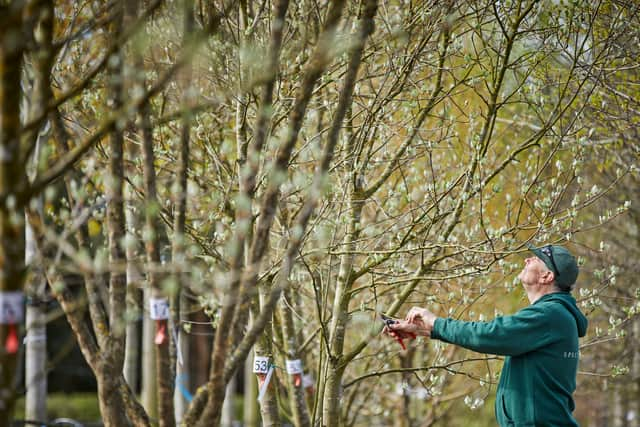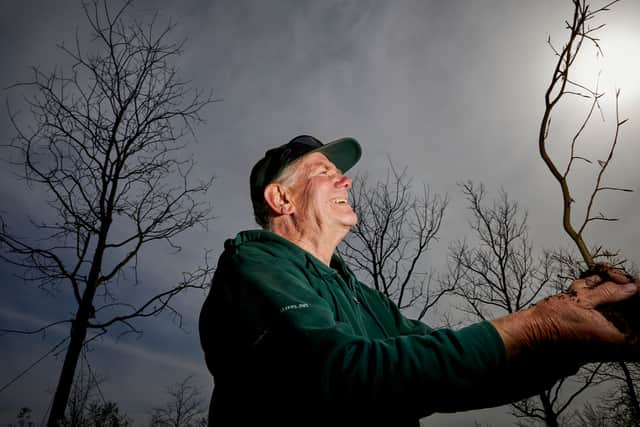New Manchester public park takes step forward as mature trees for city’s ‘green lung’ arrive in the UK
An ambitious project to totally renovate a large site in Manchester city centre has taken another significant step forward.
A collection of 140 mature trees have arrived in the UK and will be planted in Mayfield Park, the city’s newest public green space, over the coming months.
Advertisement
Hide AdAdvertisement
Hide AdIt is just one element of a huge masterplan to turn around the fortunes of a site of more than 20 acres not far from Piccadilly railway station.
What is Mayfield Park?
Mayfield Park is a 6.5 acre site close to Piccadilly railway station and forms part of a £1.5bn project to revitalise the whole district.
The green space runs along the banks of the River Medlock, one of the three rivers of the city represented by stripes on Manchester’s civic badge.
The plan is to have open lawns, riverside walkways, three new bridges over the water, play areas and a number of different seating options.


Advertisement
Hide AdAdvertisement
Hide AdThe 140 mature trees, which are of 43 different species, will be planted over the coming months along with some 120,000 plants and shrubs to create the new open area.
It is the first new public park to be created in the city for decades, and it is hoped Mancunians will be able to enjoy it from around this time next year.
Planting with an eye to the future
The trees which have been chosen for the park are not all native to this country.
Specimen Trees in Knutsford in Cheshire are currently nurturing the likes of a number of striking, 12-metre tall Austrian black pines.
Advertisement
Hide AdAdvertisement
Hide AdOther trees which will be planted include the endangered dawn redwood, the Northern red oak and the Japanese pagoda tree.
It is hoped that the finished park will broaden people’s horizons and educate them about trees from all around the world.
The team behind the park also has an eye on the potential impacts of climate change and rising temperatures, and have selected a number of trees known to thrive in slightly warmer weather than that Manchester typically experiences today.
Who is behind the new park?
The entire project, not just the park, is being brought to life by Mayfield Partnership, a public-private venture comprising regeneration specialist U+I, Manchester City Council, Transport for Greater Manchester (TfGM) and LCR, which is essentially the development arm of the Department for Transport.
Advertisement
Hide AdAdvertisement
Hide AdThe site is owned by the three public sector bodies and a few years ago a bidding competition was held for ideas to develop the area, which was won by U+I.
In 2020, the UK Government pledged £23m of investment from its Getting Building Fund – one of the largest investments in any single project – to Mayfield Park.


This investment, delivered through the Greater Manchester Combined Authority (GMCA), is part of the Government’s strategy to support “shovel ready” schemes to help drive economic recovery following the Covid-19 crisis.
What else is included in the regeneration project?
Altogether around 24 acres of land near one of the city’s biggest and most-used railway stations are set to be put to new use.
Advertisement
Hide AdAdvertisement
Hide AdThe plan is to transform the brownfield area into a mixed-used neighbourhood which will include 1,500 new homes, 1.6m square feet (sq ft) of commercial space and 300,000 sq ft of retail and leisure facilities.
Uncovering a long history in this part of the city
During the creation of the park the River Medlock, one of the three rivers flowing through the city along with the Irwell and the Irk, has been uncovered after years of being buried beneath concrete and industrial use.
This, though, is just part of a long and storied history that the area has.
During the Industrial Revolution Mayfield was a thriving hub of commercial activity, with well-known businesses in the area including Thomas Hoyle and Sons, a textile dying and calico printing works that created products which were in demand around the world.
Advertisement
Hide AdAdvertisement
Hide AdIn the early 20th century Manchester Mayfield railway station was created in the area as an overspill for Piccadilly.
However, its use for heavy industry meant that the area had high levels of pollution from coal-burning cotton mills and workers’ homes.
Turning part of Mayfield into a green lung for the city will therefore be a far cry from the days when almost no trees would even grow in the area.
In more recent times the area had seen a bit of a downturn in its fortunes and the authorities decided it would need to be renovated.
Advertisement
Hide AdAdvertisement
Hide AdVarious schemes were mooted, including one involving then deputy prime minister John Prescott having a vision of building a ‘Whitehall of the North’ there.
These, however, came to nothing, leading to the creation of the latest bidding competition for developers around half a dozen years ago.
What do the developers say?
The team behind the massive project have expressed delight and excitement at the prospect of creating an all-new green space for Manchester in Mayfield.
The arrival of the trees for the park in the UK has been hailed as a significant step in the plans.
Advertisement
Hide AdAdvertisement
Hide AdArlene van Bosch, Mayfield development director at U+I, said: “The arrival of the trees in the UK is such an exciting milestone for the creation of Mayfield Park.
“After many months of excavations, ground works and efforts to bring Mayfield’s hidden river back into view, we can’t wait to introduce these mature trees to their new home, alongside the thousands of wildflowers and plants that will bring the park to life as a vibrant, stimulating, sustainable and safe space for people to enjoy.”
“We are thrilled to have been able to procure such an interesting and diverse collection of species to populate an area where few trees have ever grown before, turning what was once a hotbed of pollution into a ‘green lung’ for the city.”
Tracey Rawlins, executive member for environment for Manchester City Council, said: “Mayfield Park will be a fantastic green addition to the city centre and help contribute to our policy of planting thousands of new trees across the city.
Advertisement
Hide AdAdvertisement
Hide Ad“As well as looking great, they help improve air quality, reduce flood risk and counter the effects of climate change by absorbing and storing carbon.
“Trees have an important role to play, which is why we have launched the £1m Tree Action MCR planting programme.”
Duncan Paybody, associate director and landscape architect at SEW, said: “Trees are a crucial feature of the park design. We have chosen a variety of native and non-natives as we think it’s important that the first park of its kind in the city centre should provide a botanical collection to enlighten people’s knowledge and awareness of tree species.
“Climate resilience has also influenced our choices so species such as Catalpas and Gledistisas represent trees tolerant of slightly warmer climates.
Advertisement
Hide AdAdvertisement
Hide Ad“We have planned for time. Seasonal autumn leaf colour, spring and summer blossoms will signal different times of the year while long-lived species such as Metasequoia and red oaks will continue to grow and provide impressive scale for future generations.”
Find out more about the project at its official website.
